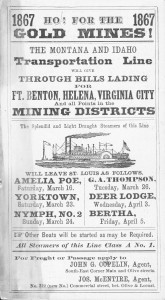“Fort Benton on the Upper Missouri is a small town with a big history.” That is the beginning of the introduction of a delightful book by Ken Robison on the history of Ft Benton. The book, Fort Benton, includes photographs and postcards from Mr Robison’s collection. One image, special to me, was a steamboat passenger boarding pass for the Montana and Idaho Transportation Line. The St Louis based line was owned by John G Copelin and his father-in-law John J Roe. According to Mr Robison, the line dominated the Missouri River commerce from 1864-68.
Look carefully at the names of the pool of boats used by the line. Thomas W Poe was the captain of the Amelia Poe and George W Ebert was the captain of the Yorktown. In 1867, one other Georgetown packet docked at Ft Benton: the Ida Stockdale in the first of five seasons. Captains Thomas S Calhoon and Jackman T Stockdale were partners and Capt Grant Marsh was the master in 1867.
The Amelia Poe docked at the Ft Benton levee on 9 Jun with 183 tons of freight and 50 passengers. Eighty-five days from St Louis. The Yorktown arived at Ft Benton on 14 Jun (84 days from St Louis) with 210 tons of freight and 15 passengers. The Nymph No 2 arrived on 20 Jul (118 days from St Louis); the GA Thompson 30 Jun; the Deer Lodge 5 Jun. The arrival of the Bertha is not recorded in “Fort Benton The World’s Innermost Port” by Joel Overholser.

